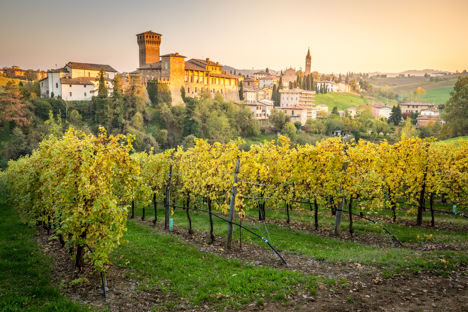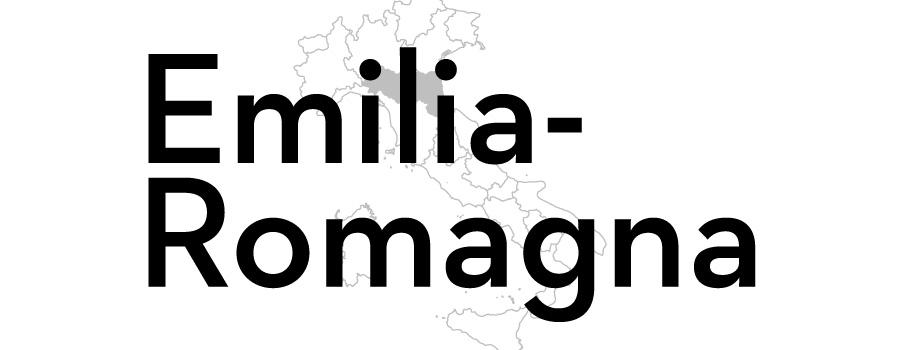
The wines of Emilia-Romagna
Marco Rossi introduces the wines of one of Italy's most famous regions, home to favourites such as Lambrusco and Albana Romagna.
View more from this series:
Italian wineJust saying the name Emilia-Romagna puts a smile on my face and fills my palate with joy. When I think of this region, of the red towers of Bologna or the crowded beaches of Rimini, I’m reminded of the slow life of the past, a happy and hospitable people, simple moments and great flavours. Maybe I'm biased; I studied and lived in Bologna and have an enormous love for Fellini, but every time I sit down to a table full of Parmigiano Reggiano, Grana Padano cheese, tortellini, lasagne, salama da sugo, tigelle or piadine, while drinking good Lambrusco or a fruity Sangiovese, I am regenerated by the tastes and ancient aromas that can be found in the region.
I will never forget tasting the wines that I believe perfectly represent this feeling. Lambrusco Grasparossa Vittorio Graziano ‘Fontana dei Boschi’, probably the most ‘abrupt’ type of Lambrusco, is jovial and melancholy at the same time, just like a clown. After a few glasses you will almost feel guilty for having forgotten the pure and simple joy of living a simple life without the distractions of modern day culture.
Emilia-Romagna is quite a young region, as before 1970 it was divided into two distinctly separate territories. Our journey will take us through these two territories, sometimes together, sometimes clearly distinct over centuries of history.
Emilia
DOCGs
This DOCG was formed in 1997 to enhance the Pignoletto, an ancient variety that was traditionally linked to farming. According to specifications, producers need to use at least 95% of Pignoletto grapes while the rest can be Riesling or Trebbiano Romagnolo. There's also an amazing sparkling version of this wine that goes perfectly with traditional Emilia boiled meat.
- Visual: light yellow with greenish reflections
- Bouquet: fruit dominates the aromatic spectrum with distinct hints of apple, peach, tropical fruits and almonds, which give way to subtle floral and herbal notes
- Taste: soft, warm and quite fresh with good structure, closing with a hint of bitter almond
- Pairing: the famous Bologna tortellini in broth are perfect with Pignoletto, but cheese, snails and grilled fish also work well
Must try:
Traditional: Az Agricola Manaresi – Colli Bolognesi Classico DOCG Pignoletto
New Wave: Monte Vecchio Isolani – Colli Bolognesi Pignoletto Frizante Classico DOCG
DOCs
Lambrusco wine deserves a separate article as there are so many types, ranging from dry to slightly sweet that we could taste. For a long time, Lambrusco was relegated to the role of a sparkling wine made just for traditional meals and frugal banquets, but today it is experiencing a moment of glory thanks to a new wave of quality producers using the Metodo Classico, used for Champagne.
As already highlighted in the early stages of this article, Lambrusco is a light, unpretentious and humble wine that can give immense joy, sometimes achieving unexpected levels of genuine elegance. The four main Lambrusco producing areas are Lambrusco di Sorbara, Lambrusco Grasparossa Castelvetro, Lambrusco Calamino of Santa Croce and Lambrusco Reggiano.
- Visual: from light pink (in the rosé version of Sorbara) to ruby red (purple is reached only in Grasparossa version), the carbonation varies depending on the method of vinification
- Bouquet: winey aromas, often linked to wort, red fruit and notes of violet
- Taste: the freshness reigns over everything else, with a beautiful acidity
- Pairing: fatty foods of the region, aged cheeses such as Grana Padano and Parmigiano Reggiano or lamb
Must try:
Traditional: Cleto Chiarli ‘Lambrusco del Fondatore’ – Lambrusco di Sorbara DOC
New Wave: Fattoria Roretto ‘Canova’ – Lambrusco Grasparossa DOC
Piacenza has been a land of wines since ancient times. Popes, kings, lords and great artists up to this day just loved the wines of this area. In the Colli Piacentini area you will find amazing blends such as Bonarda, the Gutturino and Pinot Noir rosé sparkling wine – all high quality wines made by both international varieties and native grapes.
- Visual: intense light yellow
- Bouquet:: notes of Mediterranean flowers, golden apples and ripe yellow fruit
- Taste: good correspondence between nose and palate with hints of orange and tangerine with a good length and good structure
- Pairing: Cheeses, ravioli and tortellini with pumpkin, white meats and Baccalà alla Vicentina
Must try:
Traditional: Lusenti ‘Regina Bianca’ – Colli Piacentini Malvasia DOC
New Wave: Luretta ‘Bacca di Rosa’ – Colli Piacentini Malvasia DOC
• The north-central region is bordered to the north with Lombardy and Veneto, to the west by Lombardy and Veneto, to the south with Liguria, Tuscany and Marche, and to the east with the Adriatic Sea
• The Po River is the largest of the region and it is the only one with a regular flow rate
• Emilia-Romagna has a sub-continental climate with cold winters and warmer summers towards the coast. Inland there is quite a high humidity
• Historically more devoted to producing quantity over quality, in modern times the region is now focusing on creating world-class wines
Romagna
DOCGs
The Albana is one of the oldest vines in Romagna, and producers must use only this grape when making wines to gain DOCG status. There are five different versions: dry, demi-sec, sweet, raisin and sweet reserve. During ancient times Albana was considered a poor tavern wine until Roman rule, when it was served in a golden cup due to its delicate taste.
This was the first DOCG of the unified Emilia-Romagna, originating in 1987, and one of the first DOCGs made from white grapes in Italy. The Albana name comes from the Latin albus (white).
- Visual: pale yellow with golden reflections
- Bouquet: good intensity with clear notes of peach, apricot, citrus fruits, figs and flowers, with an interesting hazelnut flavour.
- Taste: great structure and body, good flavour and lively tannins. Good roundness; enough but not too cool
- Pairing: tagliatelle or lasagna with meat sauce, duck with oranges or pork
Must try:
Traditional: Fattoria Zerbina ‘Scacco Matto’ – Albana Romagna DOCG Passito
New Wave: Santa Lucia ‘Albarara Cru Artigianale’ – Albana Romagna DOCG Secco
DOCs
Sangiovese is the most popular grape in Italy together with Pinot Noir and Nebbiolo. Outside of Tuscany – its homeland – there are only a few areas which can use it to its full potential, Romagna being one of them. For the people of Romagna, Sangiovese is almost a friend or relative that has historically accompanied them through centuries of cultural evolution. In Romagna Sangiovese is not made into wines that need ageing (as in Tuscany) – here you can get great results with young wines.
- Visual: intense ruby red with violet reflections
- Bouquet: going from notes of violet, pink and sweet spices to small red fruit pulp and cherry
- Taste: strong tannins, great structure and body with a good persistence and bitter finish
- Pairing: pasta dishes such as tagliatelle with meat sauce or lasagne, pheasant and some cheeses like Parmesan and Grana Padano
Must try:
Traditional: Fattoria Casetto de Mandorli ‘Vigna del Generale’ – Predappio Predappio IGT
New Wave: Noelia Ricci ‘Sangiovese’ – Sangiovese di Romagna Superiore DOCG
The name of this DOC is extremely interesting – in Italian it literally means ‘pays debts’. The grape is also known as Bombino Bianco but people from Romagna call it Pagadebit as, being an extremely sturdy and weather-resistant variety, it always ensured the farmers would have a safe harvest and be able to produce white wine even in bad years, helping them pay the debts accumulated during the year.
- Visual: pale yellow with green highlights
- Bouquet: very intense with aromas of chamomile, hawthorn, plum and herbs with a good minerality
- Taste: dry and extremely fresh but not necessarily persistent
- Pairing: shellfish, pasta with seafood and the classic local dish piadina
Must try:
Traditional: Podere La Berta – Pagadebit di Romagna DOC
New Wave: Podere di Vecciano ‘Vigna delle Rose’ – Pagadebit di Romagna DOC



